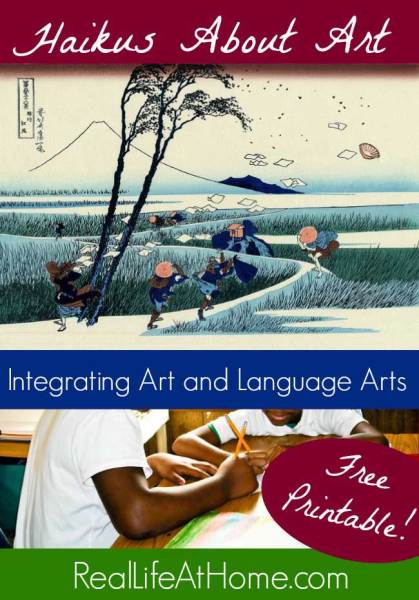advertisement
The following post is from Cindy from Art Curator for Kids:
Since I’m passionate about the power of art in people’s lives, I like to come up with activities that get kids truly engaged with the work of art. Today, I’m going to help you get your kids thinking about art through one of my favorite art learning activities–writing haiku poems about art.
I have facilitated this activity with various age groups, and it never fails to produce really inspiring results. Not only is it a great connection with your language arts curriculum, but also the kids always manage to capture the essence of the artwork in their haikus and often the essence of that artwork’s art movement/style.

advertisement
Katsushika Hokusai, Ejiri in Suruga Province, 1830-33
What’s a Haiku?
Haiku is a form of traditional Japanese poetry with origins as far back as the 17th century. It contains 17 syllables broken up into 3 lines. There are 5 syllables in the first line, 7 in the second, and 5 in the third. Traditionally, haikus are about nature, but in the 21st century, there is a lot more freedom to explore different topics.
Here is an example of a haiku (written by yours truly):
Writing Haikus about Art with Kids
This lesson will work with anywhere from 3rd grade to college. I have personally taught this lesson with middle, high, and college, but with some extra help, the upper elementary students can do this successfully as well.
I would never just give a student an artwork and say, “Here, write a haiku about this!” It’s a challenge for the students, but hard is good. Hard means they are thinking. I’ve found the lesson works best when you spend the time preparing for the haiku writing.
Here are the steps I usually take:
- Show the artwork and talk about it together. You can use the tips on this post, if you don’t know where to start. Basically describe it, figure out the story, etc.
- Make a list of descriptive words about the artwork including nouns, verbs, adjectives, and adverbs. For older students, I also have had them brainstorm phrases, similes, and metaphors about the painting as well. I’ve made you a free printable worksheet to make this easy for you. See the link to download below.
- Introduce the haiku activity. Describe what a haiku is, explain how to write one, and show an example of a haiku. Depending on the age and experience of the student, you may need to have a little syllable lesson and practice counting syllables first.
- Have students write the haiku. Younger students may need you to work through this process with them, but I say let them go and see how they do, but be available for help and encouragement of course.
- Read the haikus together and marvel at the amazing creativity of your kids.
- (optional) Then (and only then), you may research and read about the artwork. I don’t want any outside sources to impact the student’s thinking about this art. The student’s ideas are way more important than an art historian or even the artist!
I’ve created a printable worksheet for you to use with this process, you can download it here.
Artworks for the Activity
I think this activity works with almost anything, but here are some great choices to start you off:
- Weeping Woman by Pablo Picasso
- Ejiri in Suruga Province by Katsushika Hokusai
- Oath of the Horatii by Jaques-Louis David
- L’Angélus by Jean-François Millet
- Poet on a Mountaintop by Shen Zhou
Additionally, I have several collections of art on my page with lists of great artworks to look at for kids. The majority of the artworks from those lists would work well for this activity. Look for art with emotion and/or art with stories as a good place to start.
Thanks for reading, and I hope you try this activity out with your kids. If you do, let me know how it goes in the comments!
 |
Cindy Ingram was once an art teacher and museum educator and is now a work at home mom of two lovely daughters (ages 2 and 5). She is passionate about the power of art in people’s lives and writes about how to teach art appreciation and art history to kids of all ages at the Art Curator for Kids. You can connect with her on Facebook and Pinterest. |
Join 40,000+ Other Awesome People
Subscribe to the Real Life at Home weekly newsletter to get our latest content, exclusive free printables, learning activities, and ideas for celebrating with your kids all year


Leave a Reply